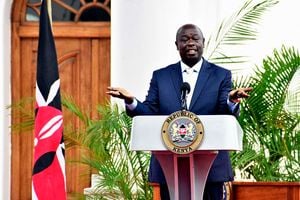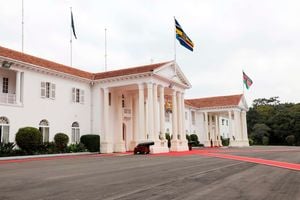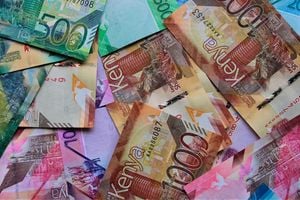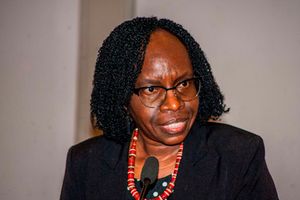
Then-President Uhuru Kenyatta (right) and his then-Deputy William Ruto during a Jubilee Party rally at Kasarani Stadium.
A special audit report on the decade reign of the Jubilee government under former President Uhuru Kenyatta and his then deputy William Ruto has lifted the lid on how the Executive spent Sh147 billion of taxpayers’ money under emergency clause.
Also, President Ruto’s Kenya Kwanza administration has not been spared the audit scrutiny, between assumption of office and its first fiscal year.
While the Constitution under Article 223 of the Constitution on Supplementary Appropriation allows the Executive to spend then seek parliamentary approval later, the special audit report has revealed how some of the projects where billions were withdrawn from the exchequer to fund, either stalled or did not serve the intended purpose.
Auditor-General Nancy Gathungu report tabled in Parliament raises a red flag on how the Executive exploited a lacuna in law to incur expenditure between 2013/2014 to 2022/2023 financial years
Also Read: Rigathi Gachagua splurges Sh10m on curtains
The audit was done following a request by the National Assembly Public Accounts Committee in April last year to determine efficiency effectiveness of supplementary budgeting process, with a view to provide proper accountability and transparency by the various ministries and State agencies.
The law requires that the approval of Parliament for any spending shall be sought within two months after the first withdrawal of the money.
“In any particular financial year, the national government may not spend more than 10 per cent of the sum appropriated by Parliament for that financial year unless, in special circumstances, Parliament has approved a higher percentage,” reads the law.
Ms Gathungu has however questioned billions spent by various ministries and State departments which took advantage of the provisions of Article 223 of the Constitution.
The report revealed that in the 2022/2023, Sh12, 506,539,749 was withdrawn for shares acquisition from the Eastern and Southern African Trade Development Bank, African-Export lmport Bank and Jamhuri Holdings Limited.
Ms Gathungu however says requests for information from the banks' headquarters were either declined or not responded hence it was not possible to confirm whether Kenyans got any benefits from the shares.
“lt was therefore not possible to confirm the ownership of the shares acquired and to determine whether there were any benefits that may have accrued to the Government of Kenya for the purchase of the said shares,” reads the report.
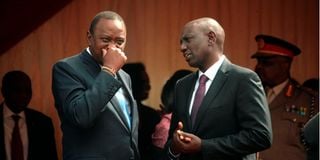
Then-President Uhuru Kenyatta (left) and his then-Deputy William Ruto.
Ms Gathungu has also questioned Sh16,270,000,000 that was advanced to Kenya Airways as a loan by the government in the financial years 2021/2022 and 2022/2023, however, the report indicates that the national carrier failed to open a GoK loan designated account, which led to commingling of funds by the entity.
“The National Treasury failed in its fiduciary role by releasing public funds without an effective mechanism of recovery, while the management of Kenya Airways PLC failed to act in good faith by not complying with the agreed covenant clauses thereto,” reads the report.
The report has also raised questions over the expenditure of Sh4 billion in the maize subsidy programme in August 2023 as it failed to achieve intended purpose. According to the report 129 millers signed contracts, but only 116 participated in the programme.
Ms Gathungu has also questioned the Sh7 billion released by Treasury in the 2022/2023 financial year for the fertiliser subsidy programme saying the farmers did not benefit from it due to the late dispatch of the commodity.
According to the report, 55 fertiliser depots in 17 counties that were sampled where the comodity was distributed, revealed that farmers did not effectively benefit from the programme as the distribution of the fertiliser was not done in time for the planting season.
Further, the audit also returned a damning feedback on the expenditure of Sh21 billion released on diverse financial years of 2016/2017, 2017/2018, 2021/2022 and 2022/2023 to the persons affected by drought as there were no guidelines on the expenditure and filing of returns.
“There were minimal guidelines on relief food distribution, failure to prepare and submit returns on food distribution, failure to fund authority to incur expenditure at the county level and incomplete distribution lists,” reads the report.
The report has also questioned the expenditure of Sh2 billion for the construction of 10,000 classrooms in secondary schools across all counties in the country due to poor workmanship of the classrooms.
“Physical inspection of the CBC classrooms revealed that there was poor workmanship, there were nine incomplete classrooms at the time of the audit and 30 classrooms were not in use,” reads the report.
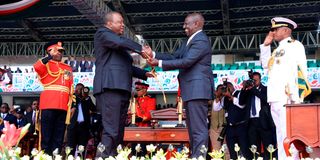
President William Ruto is handed the instruments of power by his predecessor Uhuru Kenyatta after he took the oath of office at Kasarani International Stadium on September 13, 2022
Still under education, Ms Gathungu questioned the expenditure of Sh2.4 billion used by the government in purchasing of various equipment to Technical and Vocational Education and Training institutions during the 2017/2018 financial year. The special audit revealed that eight TVETs were not utilising the equipment because of lack of the required three- phase power voltage.
The report further states that there were broken-down machines that were idle due to lack of maintenance and service agreements.
“ln addition, the equipment was delivered with no value attached to each equipment, hence it was not possible to establish the value of the equipment from the fixed assets registers provided,” reads the report.
The wastage of taxpayers’ money continues as the report reveals that Sh92 million was used by Micro and Small Enterprises Authority (MSEA) to construct cold storage and processing facilities in Nyandarua, Meru and Kisii counties in order to end post-harvest losses of potatoes in 2019/2020 financial year.
However, Ms Gathungu says there was no value for money for the facilities as at the time of the audit in September last year, the cold storage facilities were not in operation.
The audit also questioned Sh139, 149,629,785 used by the government in the stabilisation of fuel prices programme during the financial years 2020/2021, 2021/2022 and 2022/2023
ln April, 2021, the government introduced pump price stabilsation mechanism to cushion the public from the high pump prices following escalation of global prices post-Covid.
However, the report revealed that there was no legal framework for advance payment and there was no evidence of recovery of this advance in subsequent payments to the oil marketing companies.
Further, an amount of Sh2, 205,915,489 was paid as administration costs for the period ended 30 June, 2023.
However, there was no justification for including the stabilisation administration costs in the pump price build up.
The National Optic Fibre Backbone Infrastructure project, an ambitious project started by the Jubilee government in 2007 in collaboration with the government of the People's Republic of China through the Export - import (Exim) Bank of China at a cost of Sh5 billion also came under sharp scrutiny by the auditor.
The report reveals that there was unsupported expenditure by the Government of Kenya and lack of information on how the Government of the People's Republic of China, and EXIM Bank of China were identified.
The project was initiated in 2007 with an objective of building a terrestrial fibre network, whose purpose was to connect government institutions countrywide to enable digitization of government services and improvement of service delivery.

